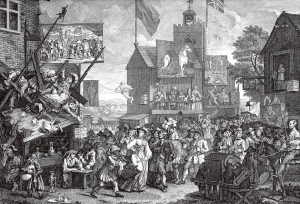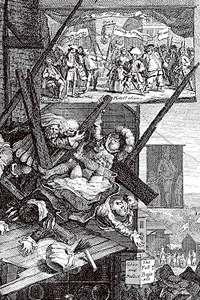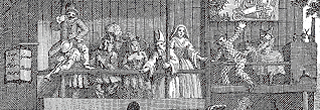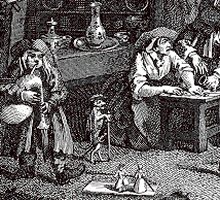Southwark Fair

- Southwark Fair
- by Hogarth (1734)
[click on the picture to enlarge it]

- Southwark Fair
- by Hogarth (1734) (details)
[click on the picture to enlarge it]
This fair started during the reign of Edward IV of England (1461 - 70 ; 1471 - 83). In 1462 a royal charter authorised the City of London to set up an annual fair from the 7th to the 9th of September on the site of St. Margaret’s Hill. The charter was renewed in 1550 under King Edward VI (1547 - 1553). Southwark very quickly gained importance and its duration increased (from 3 days to 2 weeks).
In the course of the 18th century, several attempts to reestablish the original duration of the fair proved ineffective. In 1710 several warrants were issued for the arrest of fair stall holders who did not respect the three days stipulated in the regulations. In 1718 it was decreed that fair booths that did not respect the by-law would be taken down and the owners prosecuted. The decree was even bill-posted on the town walls so that none remained in ignorance of the regulation. In 1743 the neighbourhood inhabitants, fed up with evident complete indifference of the stallholders to the regulation, decided to take the latter to court " in order to preserve the Morals of their Children and Servants from being Corrupted (Daily Post, 23 August 1743). This action met with popular hostility and a sort of riot resulted which deeply alarmed critics of the Fair.
In 1750 a new petition was addressed to the Lord Mayor demanding the suppression of this fair " tending only to the Destruction of Youth of both Sexes, and the Encouragement of Thieves and Strollers (Penny London Post, 6 August 1750). The Daily Advertiser of the 18th September warned its readers that the Southwark Fair would, from then on, take place from the 18th to the 20th September. The stallholders who would not take account of these new official dates would have trouble with the law. The law was once again openly flouted and the local authority was forced to reiterate the decree the following year, without much more success.
Finally, this game of cat and mouse between stall holders and the forces of law and order came to an end on 22nd June 1762, when the City of London council decreed that Southwark Fair be closed down. In 1763, several stall holders who tried to set up their booths in defiance were forcibly expelled by the police.
In 1718 a new attraction from France contributed still further to the popularity of Southwark Fair. It consisted of a dance act performed by dogs dressed up in crinoline and flouncy petticoats. According to the Daily Courant of the 6th September 1718 : “Their dresses, as well as their dances, being entirely after the French mode particularly Miss Depingle in her Hoop petticoat and leading strings.”
From 1720 the number of theatre performances increased. That year, The Italian Shadow was the first mime show played at Southwark Fair after its launching at Lincoln’s Inn Fields Theatre. It was not unusual that audiences were presented plays at Southwark Fair that had already been successful at Bartholomew Fair. Thus, Penkethman put on The Injur’d General, or The Blind Beggar of Bethnal Green in 1721 and The Distressed Beauty or the London Prentice in 1722, two plays that the public had already been able to see at Bartholomew Fair.
The Siege of Troy was without a doubt one of the most performed plays on stage both at Bartholomew Fair and Southwark Fair because of its success with the public : The Whole Entertainment having been justly Acknowledg’d by all the Spectators, to be infinitely superior to all Public Performances of this kind ever seen in a Fair (Daily Journal, 26 September 1725). The keen interest shown by Londoners for The Beggar’s Opera was just as noteworthy.
The ‘theatrical booth’ owners, eager to attract people of quality to their rooms , had advertisements published in the press specially for them, identical to that in the Weekly Journal of 16 September 1721 : “There is a Passage thro’ the Half Moon Inn for the Quality to the Boxes, and a handsome Long Room joining to the Booth, where will be Raffling and other Diversions.” This advertisement was appealing, because it vouched spectators the means of going directly to the theatre without mixing with the populace and without risk of wading about in the mud.
The ‘Theatre Licensing Act’ of 1737 put an end to this surge of theatre in Fairs. Performances did not really pick up again until 1748, but the strict limitation on the duration of the fair to three days in 1752 scarcely encouraged actors from the London Theatres to appear on stage at Southwark Fair. The strolling players who replaced them were not as appreciated by the public, who little by little ceased to attend Southwark Fair.
The Attractions of Southwark Fair

- Southwark Fair
- by Hogarth (1734) (details)
[click on the picture to enlarge it]
Originally an open-air market, Southwark Fair completely changed over the years into a place of attractions, offering Londoners from 1720 similar distractions to Bartholomew Fair : mime shows, farces, song and dance shows, conjuring tricks, puppets, acrobats and rope dancers. Numerous public houses also guaranteed the Fair’s success.
From 1717 the actor William Penkethman, already mentioned in connection with Bartholomew Fair, had a spacious ‘theatrical booth’ set up in order to accommodate a select public to whom he offered a farce titled Twice Married and a Maid Still, or Bedding makes the Bargain Fast which was a huge success. It was at the end of one of these performances, on the 13th of September 1717, that the local police stormed into the room before the reproving looks of the audience, made up that evening of members of high society. Penkethman, accused of failing to comply with the closing date of the Fair, was arrested as well as his troupe of players. Penkethman, confident because of his rights as appointed court actor and for this reason placed under royal protection, took legal action against the constables, as the Weekly Journal reported in an article dated 20th September 1717 : “We hear that Mr. Penkethman will bring his Action against the informing Constables for breaking open his Booth last Friday, and taking him off the Stage contrary to the King’s patent, under the Umbrage of which he acts, being Sworn Servant to his Majesty, especially against such of them as were out of their liberty, when they executed that Office.”
Consequently, Penkethman won the case and in following years was able to continue his performances which were very much appreciated by the public because of the quality of the plays chosen and the excellent acting. Some of the actors, such as James Quin and Lacy Ryan were already quite famous.

- Southwark Fair
- by Hogarth (1734) (details)
[click on the picture to enlarge it]
In 1718 a new attraction from France contributed still further to the popularity of Southwark Fair. It consisted of a dance act performed by dogs dressed up in crinoline and flouncy petticoats. According to the Daily Courant of the 6th September 1718 : “Their dresses, as well as their dances, being entirely after the French mode particularly Miss Depingle in her Hoop petticoat and leading strings.”
From 1720 the number of theatre performances increased. That year, The Italian Shadow was the first mime show played at Southwark Fair after its launching at Lincoln’s Inn Fields Theatre. It was not unusual that audiences were presented plays at Southwark Fair that had already been successful at Bartholomew Fair. Thus, Penkethman put on The Injur’d General, or The Blind Beggar of Bethnal Green in 1721 and The Distressed Beauty or the London Prentice in 1722, two plays that the public had already been able to see at Bartholomew Fair.
The Siege of Troy was without a doubt one of the most performed plays on stage both at Bartholomew Fair and Southwark Fair because of its success with the public : The Whole Entertainment having been justly Acknowledg’d by all the Spectators, to be infinitely superior to all Public Performances of this kind ever seen in a Fair (Daily Journal, 26 September 1725). The keen interest shown by Londoners for The Beggar’s Opera was just as noteworthy.
The ‘theatrical booth’ owners, eager to attract people of quality to their rooms , had advertisements published in the press specially for them, identical to that in the Weekly Journal of 16 September 1721 : “There is a Passage thro’ the Half Moon Inn for the Quality to the Boxes, and a handsome Long Room joining to the Booth, where will be Raffling and other Diversions.” This advertisement was appealing, because it vouched spectators the means of going directly to the theatre without mixing with the populace and without risk of wading about in the mud.
The ‘Theatre Licensing Act’ of 1737 put an end to this surge of theatre in Fairs. Performances did not really pick up again until 1748, but the strict limitation on the duration of the fair to three days in 1752 scarcely encouraged actors from the London Theatres to appear on stage at Southwark Fair. The strolling players who replaced them were not as appreciated by the public, who little by little ceased to attend Southwark Fair.

